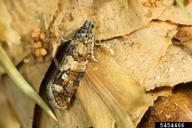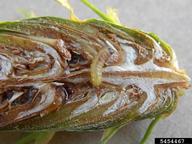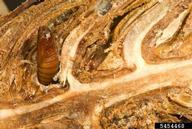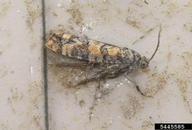Douglas-fir cone moth
Barbara colfaxiana (Kearfott) (Lepidoptera: Tortricidae)
Orientation to pest
The Douglas-fir cone moth, Barbara colfaxiana (Kearfott), is found in western North America from California to British Columbia, east to Montana, and Colorado. Adults emerge in the spring and lay their eggs on young cones. Young larvae feed largely on cone scales, but older larvae consume developing seeds. Pupae overwinter in papery, resin-coated cocoons in center of cones. Pupae may remain in diapause for as long as 3 years. Damage occurs on Douglas-fir (Pseudotsuga menziesii [Mirb.] Franco) and true firs (Abies) and is greatest at inland (non-coastal) sites, where summers are hotter and drier. One larva can destroy 60% of the seeds in a cone, while three larvae will likely destroy all of the seeds. There is one generation per year. Pheromone traps using the pheromone of Contarinia oregonensis Foote, can be used to monitor the pest.
Hosts commonly attacked
In North America, this moth attacks Douglas-fir (P. menziesii) and various true firs (Abies).
Distribution
In North America, this moth occurs is recorded from California to British Columbia, east to Montana, and Colorado.
Images of Douglas-fir cone moth
| Figure 1. Adult of Douglas-fir cone moth, Barbara colfaxiana | Figure 2. Larva of Douglas-fir cone moth | Figure 3. Pupa of Douglas-fir cone moth | Figure 4. Douglas-fir cone moth, Barbara colfaxiana, caught in trap baited with pheromone of Contarinia oregonensis |
Important biological control agents related to this pest species
The ichneumonid Glypta evetriae Cushman is reported as a parasitoid of this species.
Web links for information on Douglas-fir cone moth
- Fact Sheet and Management Guide from FETCH 21 | University of British Columbia
- Pest Leaflet No. 8 | Forest Genetics Council of British Columbia
Articles
- Clark, E. C., J. A. Schenk, and D. L. Williamson. 1963. The cone-infesting moth Barbara colfaxiana as a pest of Douglas-fir in northern Idaho. Annals of the Entomological Society of America 56: 246-250.
- Hedlin, A. F. 1974. Cone and seed insects of British Columbia. Canadian Forestry Service, Pacific Forestry Research Centre, Victoria, BC. BC-X-90. 63 pp.
- Nebeker, T. E. 1977. A partial life table for the Douglas-fir cone moth, Barbara colfaxiana (Lepidoptera: Olethreutidae). The Canadian Entomologist 109: 943-951.
- Sweeney, J. D. and G. E. Miller. 1989. Distribution of Barbara colfaxiana (Kearfott) (Lepidoptera: Tortricidae) eggs within and among Douglas-fir crowns and methods for estimating egg densities. The Canadian Entomologist 121: 569-578.
- Koerber, T. W. and G. P. Markin. 1984. Metasystox-R® injections increase seed yield of Douglas-fir in California, Oregon, and Washington, pp. 137-146. In: Yates, H. O., III. (ed.). Proceedings of the Cone and Seed Insects Working Party Conference. Asheville, North Carolina, Southeastern Forest Experiment Station.







